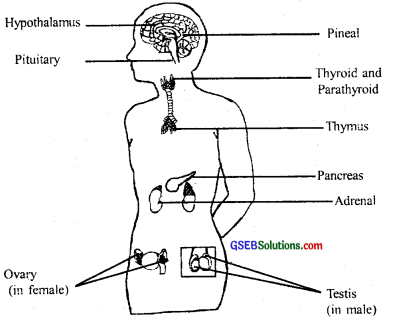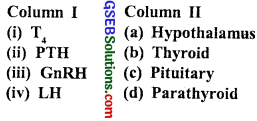Gujarat Board GSEB Textbook Solutions Class 11 Biology Chapter 22 Chemical Coordination and Integration Textbook Questions and Answers.
Gujarat Board Textbook Solutions Class 11 Biology Chapter 22 Chemical Coordination and Integration
GSEB Class 11 Biology Chemical Coordination and Integration Text Book Questions and Answers
Question 1.
Define the following.
- Exocrine gland
- Endocrine gland
- Hormone
Answer:
- Exocrine gland: Secretions of these glands are carried by ducts, e.g., Salivary glands, liver, etc.
- Endocrine gland: These glands have no ducts and their secretions are carried by blood e.g., pituitary gland.
- Hormone: Hormone is the secretion of the ductless gland which regulates and coordinates specific body functions.
![]()
Question 2.
Diagrammatically indicate the location of the various endocrine glands in our body.
Answer:
The endocrine glands and hormone-producing diffused tissues

cells located in different parts of our body constitute the endocrine system. The pituitary, pineal, thyroid, adrenal, pancreas, thymus, and gonads are the organized endocrine bodies in our body.
Question 3.
List the hormones secreted by the following:
- Hypothalamus
- Pituitary
- Thyroid
- Parathyroid
- Adrenal
- Pancreas
- Testis
- Over
- Thymus
- Atrium
- Kidney
- G-I-Tract
Answer:
- Gonadotrophin (GnRH), Somatostatin
- Growth Hormone (GH), Prolactin (PRL), thyroid-stimulating hormone (TSH), adrenocorticotropic hormone (ACTH), luteinizing hormone (LH) and follicle-stimulating hormone (FSH), melanocyte-stimulating hormone (MSH), Oxytocin, vasopressin, glucocorticoids, androgens, anti-diuretic hormone (ADH).
- Thyroxine (T4) and triiodothyronine (T3), thyrocalcitonin (TCT).
- Parathyroid hormone (PTH)
- Adrenaline or epinephrine and noradrenaline or norepinephrine, emergency hormones ‘Fight or Flight, corticoids
- Glucagon, insulin
- Androgens (testosterone)
- Estrogen and progesterone
- Thymosins
- Atrial natriuretic factor (ANF)
- Erythropoietin
- Gastrin
![]()
Question 4.
Fill in the blanks:
Answer:

Question 5.
Write short notes on the functions of the following hormones:
- Parathyroid hormone (PTH)
- Thyroid hormones
- Thymosins
- Androgens
- Estrogens
- Insulin and Glucagon
Answer:
1. Parathyroid hormone (PTH)-Functions :
(1) The hormone enhances the level of calcium ions in the blood plasma since it shifts a lot of calcium from bones to the blood plasma and reduces the passing of calcium in the urine.
(2) Low level of calcium in the blood under feedback control enhances the level of parathormone which again restores the normal Ca” concentration in the plasma.
(3) The hormone lowers the level of phosphate concentration in the plasma of blood and increases the phosphate concentration in outgoing urine.
(4) It regulates the metabolism of calcium and phosphorus in the blood. Proper calcium and phosphorus balance are essential for the growth of bones and teeth, for the toning of muscles, and for normal nervous activity. Calcium is vital for blood clotting and for the activity of many enzymes. The hormone plays an important role in homeostasis, for activities such as membrane permeability, cardiac function, and reproduction. Parathormone in conjunction with vitamin D increases active absorption.
2. Thyroid hormones Functions:
(1) These increase the metabolic rate of the body and thus cause an increase in heat production. These maintain basal metabolic rate (BMR). It speeds up the oxidative energy-releasing process. This effect is known as a calorigenic effect.
(2) Thyroid hormones stimulate the absorption and consumption of glucose in the cells and glycogenolysis in the liver and muscles.
(3) These increase the synthesis of proteins, RNA, and lipids. It causes catabolism of lipids.
(4) These promote the growth of body tissues and cause physical growth and development of mental faculties.
(5) Thyroxin controls body weight, accelerates the rate of heartbeat, and brings about increased utilization of oxygen and release of CO2, It also controls the functioning of the adrenal cortex and gonads.
(6) Thyroxin also affects the physiology of excretion.
3. Thymosins : Functions:
These control the growth of the skeleton, development of sex glands, accelerates attainment of sexual maturity, an increase in body immunity. It stimulates cell division and influences body growth.
4. Androgens : Functions:
Androgens regulate the development, maturation, and functions of the male accessory sex organs like epididymis, vas deference, seminal vesicles, prostate gland, urethra, etc. These hormones stimulate muscular growth, growth of facial and axillary hair, aggressiveness, low pitch of voice, etc. Androgens play a major stimulatory role in the process of spermatogenesis. Androgens act on the central neural system and influence male sexual behavior. These hormones produce anabolic (synthetic) effects on protein and carbohydrate metabolism.
5. Estrogens : Functions:
Estrogens produce wide-ranging actions such as stimulation of growth and activities of female secondary sex organs, development of growing ovarian follicles, the appearance of female secondary sex characters (e.g like the high pitch of voice, etc.), mammary gland development. Estrogens also regulate female sexual behavior.
6. Insulin and Glucagon:
Functions: Insulin is a peptide hormone, which plays a major role in the regulation of glucose homeostasis. Insulin acts mainly on hepatocytes and adipocytes and enhances cellular glucose uptake and utilization. As a result, there is a rapid movement of glucose from the blood to hepatocytes and adipocytes resulting in decreased blood glucose levels (hypoglycemia). Insulin also stimulates the conversion of glucose to glycogen (glycogenesis) in the target cells.
The glucose homeostasis in the blood is thus maintained jointly by the two, i.e., insulin and glucagons. Diabetic patients are successfully treated with insulin therapy. Glucagon is a peptide hormone and plays an important role in maintaining normal blood glucose levels. Glucagon acts mainly on the liver cells (hepatocytes) and stimulates glycogenolysis resulting in increased blood sugar (hyperglycemia). In addition, this hormone stimulates the process of gluconeogenesis which also contributes to hyperglycemia. Glucagon reduces cellular glucose uptake and utilization. Thus, glucagon is a hyperglycemic hormone.
![]()
Question 6.
Give examples of:
- Hyperglycemic hormone and hypoglycemic hormone
- Hypercalcemic hormone
- Gonadotrophic hormones
- Progestational hormone
- Blood pressure-lowering hormone
- Androgens and estrogens.
Answer:
- Glucagon and Insulin
- Reduce cellular glucose uptake and utilization
- LH and FSH (Luteinizing hormone and Follicle-stimulating hormone
- Adrenal
- Atrial natriuretic factor (ANF)
- Epididymis, vas deference, seminal vesicles, prostate gland, urethra, etc. estrogens.
Question 7.
Which hormonal deficiency is responsible for the following:
- Diabetes mellitus
- Goiter
- Cretinism
Answer:
- It is due to failure of insulin secretion
- The thyroid is overactive and secretes an excessive amount of thyroid hormones.
- It is due to over secretion of somatotropin from childhood.
![]()
Question 8.
Briefly mention the mechanism of action of FAH.
Answer:
Follicle-stimulating hormone (FSH) stimulates the testes in males and ovaries in females to release sperms in males and ova in females. It also causes a release of female sex hormones i.e, estrogens in female griffin follicles.
Question 9.
Match the following

Answer:
- Thyroid
- Parathyroid
- Hypothalamus
- Pituitary